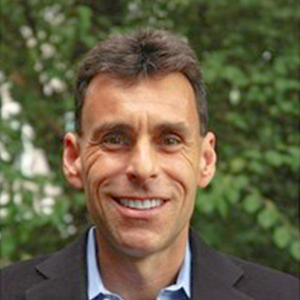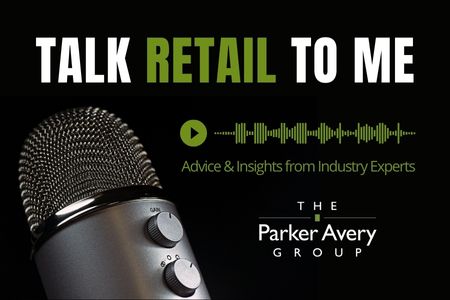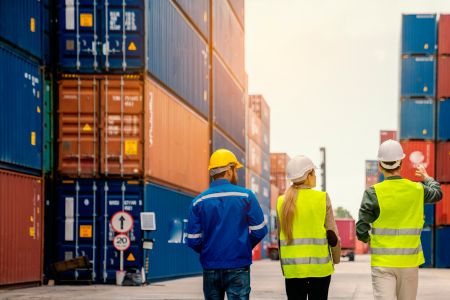Ask the Experts:
The New Role of Retail’s Chief Supply Chain Officer
In a recent episode of Parker Avery’s Talk Retail to Me podcast, Parker Avery’s Chief Executive Officer, Robert Kaufman shares his insights about the changing role of the retail chief supply chain officer during an interview with media outlet Modern Retail (see the published piece, “As supply chain disruption eases, apparel brands are tapping new leaders to manage operations“).
Robert discusses how changes in consumer shopping behaviors, combined with global macroeconomic events and disturbances, have added great complexity, challenges, and risks to the retail supply chain. These issues continue to prevent a reliable and consistent flow of goods for even the largest and most sophisticated retailers and have dramatically altered the chief supply chain officer’s role and impact on the company’s success.
Robert outlines new characteristics the executive-level supply chain and operations roles must possess to be successful as he addresses questions such as:
- What is pushing brands into hiring new supply chain leaders or COOs?
- How have retail inventory planning and supply chain planning changed in recent years?
- What type of qualities are retailers looking for in their new chief supply chain officers?
- What are some of the major challenges that supply chain officers will face in the near future?
Listen to the Podcast
Read the Interview Transcript
What do you think is pushing apparel brands into hiring new COOs or new supply chain leaders?
Robert: Well, there’s a lot of change going on in general in this market and supply chain with what happened during the pandemic, even though a lot of those things have calmed down a bit and gotten a little bit more normal, there’s still a lot of disruption, and companies are quite honestly still displeased with their own performance with regard to supply chain.
I’m always marveling at all the shuffling of leaders in these companies, not just at the COO/chief supply chain officer level, but also at the CEO level. I think part of it is there’s a lot of leadership, true top-of-the-heap CEO changes, and they bring in their own team and want people who they feel a trustworthiness that can bring some change.
But even when that isn’t the reason, it’s become more of a customer-centric role. What I mean by that is in the past, the supply chain has been more insular and you could “hide” as the COO and chief supply chain officer pre-pandemic. And usually, unless there was just some complete calamity, nobody knew what you were doing and things operated pretty well.
With what happened with the pandemic and since, if you don’t have your inventory in the right place at the right time, with a reasonable cost and reliability in your supply chain, you’re not going to be around very long. So the role has become very high impact on people who can step up and be leaders and are comfortable with that change and dynamic environment.
But not everybody was that way. In my experience, some people who had previously been in those roles weren’t forward-facing or wanted to be in that limelight. And when I say limelight, you don’t get a lot of “attaboys” or “attagirls” when things go well, but when something doesn’t, the spotlight is on you.
So being able to have the resilience and the leadership to be able to overcome some of those things are traits that companies are looking for. It’s really around the customer: having your distribution centers full of inventory, your stores full of inventory, and if it’s not what the customer wants and where the customer wants to be served (which is all about omnichannel).
In years past and maybe 8, 10 years ago, it wasn’t that way. Customers and consumers are much more in control now, especially in the younger generations. Folks now are just not that way. “If it’s not where I want it when I want it, I’ll go look elsewhere.” And so the role of the head of supply chain or chief operating officer is to partner internally if they’re a retailer, with stores, with their e-commerce team, with their merchandising team. It all has to be one cohesive mashup if you will. Otherwise, it’s just not going to work. So the role has just become much more integral to the success of the company.
The role of the head of retail supply chain or chief operating officer is to partner internally with stores, their e-commerce team, and their merchandising team.
Tell me a little bit more about how inventory planning and supply chain planning have changed in recent years. Just a couple of years ago, a lot of apparel companies were hoarding products for the holiday, and now they’re going for a leaner type of inventory. So tell me a little bit more about how the strategy has changed.
Robert: Well, we went through a just-in-time model before the pandemic, and that was because the supply chain was reliable. If something was out of stock or you needed to replenish, you had a fairly good confidence that you were going to be able to get that product back. Then things changed, and last year in particular with the pandemic, everyone was nesting.
They assumed everything was going to continue that way, and retailers bought with that same mindset. And then they were caught with an inordinate amount of inventory last year because they had bought the wrong product. They hadn’t thought about the fact that post-pandemic, people were going to want to be experiencing things. They weren’t going to want to be in their home. And so the product mix and even the fact that they were buying more lifestyle experiences than products changed. Companies had to react and probably overreact a little bit and said, “Now we need to be really lean again,” but also noted that they still don’t have confidence in the reliability of the supply chain.
So there’s surely been a pullback on the amount of inventory in the supply chain. I think it’s going to be a really interesting holiday in that, I don’t think they’re going to run out of product, but you’re not going to see a glut. There’s going to be almost like a Zara scarcity-type model where if you don’t buy it soon, you might not have it.
I think retailers are comfortable with that model. Nobody wants to lose sales, but they don’t want to have excess inventory that they have on their hands either. The cost of capital has gone way up with interest rates and such, and so that whole model—I don’t want to say it’s turned on its head. It’s always been about trying to predict what that is, but there’s less comfort in carrying extra safety stock and having extra inventory in various places. They’d rather serve their best customers and nobody wants to sell out, but be in that position and say, “Okay, we had a really good season and we’re not carrying a whole lot going into 2024,” than the opposite.
Nobody wants to lose sales, but they don’t want to have excess inventory that they have on their hands either.
What type of qualities do you think brands are looking for in their new chief supply chain officers?
Robert: In terms of interpersonal skills, they’re collaborative across the organization. They’re resilient. They’re change agents. They have to be able to be part of these major initiatives and transformations.
I think they also have to be more tech-savvy. These digital transformations, which has been a buzzphrase over the last few years, need to be part of that because the ability to get real-time information to be able to react when things happen is incredibly important.
In the past (not their fault), COOs and chief supply chain officers were left to deal with the information that they and their IT counterparts were able to provide. Now they are pushing for real-time inventory information and real-time visibility into what’s going on in the supply chain. That mindset is also a really important difference in recent years. That is going to differentiate those that are very successful and those that aren’t.
What would you say are some of the major challenges that these new COOs or supply chain officers will potentially face in the coming months?
Robert: Well, every day I read about waning consumer confidence. They could do a great job and we as consumers might decide that we’re just not feeling as confident as we would like, and we’re not going to make that extra purchase or whatever it might be.
And those products accumulate and they could be left, as I mentioned earlier with overstocks, or retailers could be in a situation where world events cause things to change radically.
I was just reading earlier about the exiting from China. As I’m sure, you know, a lot of companies have pulled out of China. It was perhaps originally for the tariffs that Trump put down, but now it’s out of fear that God forbid we were to get into a war or a major conflict and they might not allow any of the products out and into the United States. So, as a head of the supply chain, it’s important to have an understanding of world events and all the things that could impact the supply chain, the customer side, the geopolitical side, and the economic side.
I had thought about being a COO 10 or 15 years ago. Had I known about all those things, I think I would have talked myself out of it because it’s a nearly impossible equation to be able to solve. But what they do have to do is, as I mentioned, be resilient, be prepared, and have contingencies in place or they and their companies aren’t going to fare well. Not to be gloom and doom, but those are kind of the things that I’m thinking about that they should be concerned with.
As a head of supply chain, it’s important to have an understanding of world events and all the things that could impact the supply chain, the customer side, the geopolitical side, economic side.
Anything else you’d like to add about this topic?
Robert: It’s not just for your chief supply chain and COOs, but there’s a growing social concern about sustainability and the environment. Especially for apparel companies, there’s a lot of pending legislation and standards that could come out both in the United States and Europe that are going to require additional compliance around green gas emissions. It’s important to understand all the way back to the farm, if you’re in apparel, is the cotton sustainably sourced? Is it prison labor that’s doing the picking? Things like that.
So, the job, as we just talked about, is hard, and now it’s going to get even more difficult. The really progressive companies are starting to be, I won’t say proactive, but at least reactive to these things and being able to be prepared for whatever this legislation is. They’re able to prove that particular sets of goods were made in sustainable places and with free labor and such.
It’s not going to be long before there’s going to be QR codes on the product and a person can take their phone and see all the way where the chain of custody was up and down the supply chain. For companies that aren’t going to be able to do that as quickly, they’re going to be asked by their consumers and their brand advocates, “Why not?”.
It’s another dimension that’s being added onto the plates of the chief supply chain officers and their teams. They might hire an environmental sustainability lead to focus on that. Those things aren’t going away. They’re not as clear exactly what they’re going to be just yet, but they’re not far from becoming imperatives for these companies to have to deal with.
You may also like




